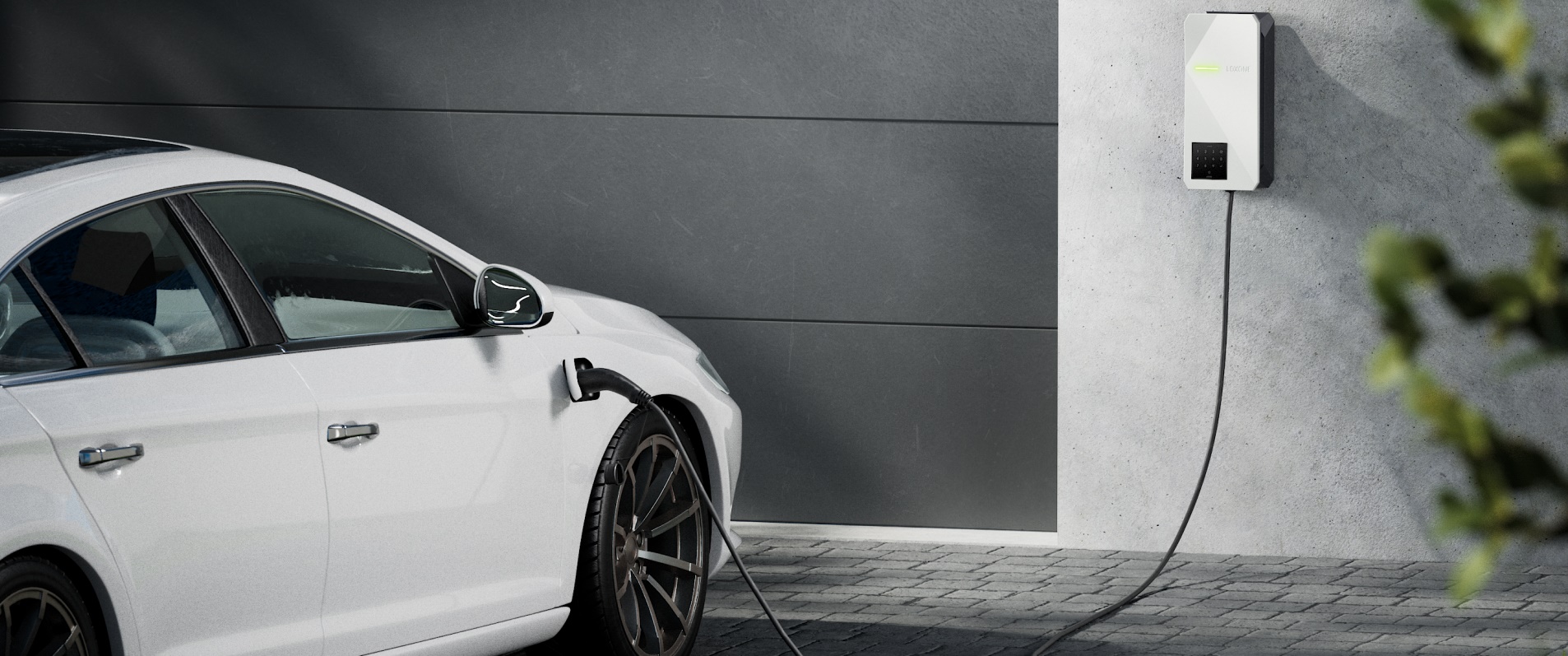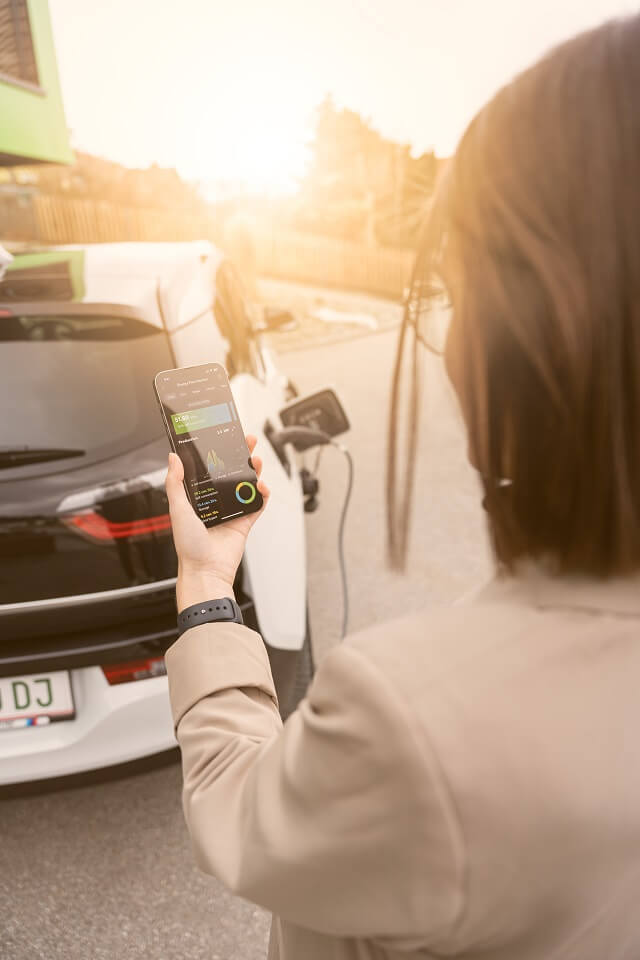
Wallbox in focus
The Loxone Wallbox is the perfect solution for convenient and economical electric vehicle charging for households and businesses. The charging station can work in harmony with other smart features such as the photovoltaic system to maximise reusable energy consumption. Our Loxone Partners can install a system that meets your requirements and makes the most of the Loxone Wallbox’s variable charging feature.
How does wallbox charging work?

What is a wallbox?
Wallbox charging refers to a category of electric vehicle charging stations (also referred to as EV chargers or EV charging stations) that provide a dedicated solution that’s safer, faster and more energy efficient than using a domestic outlet such as a household socket. These appliances can be connected to the mains power or a solar panels.
Why use a wallbox instead of a power socket?
To understand this, we’ll first discuss the difference between power and energy. A regular household socket delivers 2.3kW of power at a maximum. Walboxes come in 3 options: 7.4kW, 11kW and 22kW (although only a limited amount of vehicles require and therefore should use this load). These numbers describe the maximum amount of electrical power available from the source. Once we start using the power for a purpose with a device, in this case by charging our electric vehicle, these measurements turn into kWh, the measurement for energy used by an appliance when it’s connected to a power source. This is where the true potential of wallbox chargers surpasses the regular household socket: charging your e-vehicle for 4 hours with maximum 2.3kW fills your battery with a maximum of 9.2kWh, while maximum 7.4kW can give you up to 29.6kWh for the same time. In other words: if your car battery’s capacity is 40kWh, a 7.4kW wallbox will take approximately 5.5hrs. A household socket would do the same in 17.4hrs – over half a day. Because wallboxes are dedicated to handle these higher power loads, they are significantly faster and therefore more convenient.

Which wallbox charger should I choose?
Your electric car has a maximum charging power limit. This can range from 2.3kW to 22kW, with 11kW being the most common on the market. It’s recommended that you install a wallbox that meets your car’s exact requirements for many reasons. While the list of cars that support more than 11kW is very short, this might change later down the line. So it’s about understanding the maximum input that your vehicle can handle whilst keeping the future of EVs in mind to find the sweet spot for the most cost-effective options.
One additional thing to keep in mind is that wallboxes can be either single-phase or 3-phase. 1-phase chargers are usually available in either 3.6kW or 7.4kW options, while 3-phase is available in either 11kW or 22kW options. Your electric car will have a predefined charging phase assigned. If you have to charge your 1-phase car from a 3-phase source and vice versa, the charge will always be single-phase with maximum 7.4kW. Whilst this is interesting to know, it depends on the brand of wallbox whether there is a large enough price difference for this to be a swaying factor when choosing between different wallbox versions. Where additional cost may vary between 1-phase and 3-phase is the installation itself, so this is worth discussing with the professional installer.
Where can wallboxes be installed?
Wherever your most preferred parking space is will be the most ideal spot for your wallbox. It’s also best to install the charger on the same side as your car’s charging port is. Off-street parking is necessary to avoid causing a trip hazard on the pavement. To be able to monitor and control the wallbox’s energy consumption or schedule automated charging from your smartphone even if you’re away from home, installing the wallbox close to a WiFi source is recommended.

Are wallboxes sustainable?
Driving an electric or hybrid vehicle means your carbon emission and fuel consumption are lower compared to travelling by a regular car. If you connect your wallbox to a PV system, it harnesses the power of nature and charges your EV with reusable green energy. If the wallbox is integrated into your energy management system, it will be able to receive solar power that’s not being used by other appliances. This process can be automated, meaning you won’t need to manually track and operate the flow of reusable energy from your solar panels to your wallbox. With this synergy, you will save on additional power consumption to help the environment through sustainable methods of transportation.
While the long-term sustainability topic of electric vehicles as a whole is somewhat in its infancy – considering the emissions from the manufacturing process, the life cycle of the battery, and the subsequent recycling process – being more conscious of the means in which we charge electric vehicles (i.e. using surplus solar) can only be a good thing. Therefore when choosing a wallbox, identifying one that can be integrated into your home with more intelligent consideration for how energy is produced and consumed specifically in your household, can make a world of difference when it comes to being truly sustainable. Whilst this might be a slightly higher initial investment, the long-term benefit is undeniable.
The cheapest solution for EV charging
Electricity is traded either on the futures market or the spot market. While long-term contracts with a high level of planning security are concluded on the futures market, the spot market fluctuates based on electricity supply and demand over in the next 24 hours. For example, the power produced by wind turbines depends heavily on the weather and is therefore subject to continuous fluctuations. These fluctuations affect the electricity prices on the spot market and lead to dynamic tariffs that offer enormous potential for cost savings when used. As mentioned above, investing in a wallbox that is able to take electricity prices into consideration means you could charge your car at the most practicable and cheapest possible time. So even if you don’t have solar panels, you can still be economically sustainable.
Energy costs on the spot market are usually at their highest between 4-7pm. Most people get home from work around this time and start with the evening’s activities, such as plugging their electric vehicle in to charge, which makes this process very expensive. Avoiding this time of day and using power when the wholesale price of the spot market is lower can lead to significant savings that will add up day after day. This low-cost window is normally between the hours of 2-5am.
The Loxone smart charging system can intelligently activate a compatible wallbox to automatically start at the most convenient times based on the electricity price. To learn more, visit our blog post about the spot market or watch the below video.
Features for everyone
The Loxone Wallbox has something to offer for all buildings, whether it’s family homes or commercial premises, especially when it’s integrated with the Loxone energy management system for more efficiency.

Store and control solar power
The Loxone Wallbox can vary the rate of charge (from as low as 1.38kW). A threshold for solar surplus can be set (for example over 1.4kW) that will trigger the system to activate solar power charging for the Wallbox. If there is no car plugged in or the battery is full, the same Loxone system can redirect the surplus energy to something else (e.g dishwasher, immersion heater, etc). The sequence of distributing solar power will always be based on the priority set within the Miniserver. It’s possible to charge your vehicle with solar energy only, but if you need it ready as quickly as possible, you can switch the Wallbox on manually.

Load management via the Miniserver
The Miniserver controls the charging of your vehicle with respect to other loads across the building. If a potential overload is identified by the Loxone system, appliances are proactively disconnected according to preset priorities and current needs.

Authentication with NFC Code Touch
By adding an NFC reader to your Wallbox, you can assign charging to designated users only, and the Loxone automated system will record their consumption accordingly. You can also assign authorisation across different sites with the Loxone Trust function. This means an employee on a business trip can charge their car with the same NFC fob via the local Wallbox in London and in Birmingham.

Data export for third parties
The perfect solution to manage and invoice hotel guests and employees. They can use the same card for room access and authentication for charging. The usage data can simply be exported in CSV format for the finance department to streamline billing. They can use the same card for room access and authentication for charging.

Management of multiple chargers
The Loxone system autonomically distributes the available power between several Wallboxes – whether they are in an office parking lot, in the garage of an apartment building or at a supermarket. 50 Wallboxes work next to each other without any problems at the Loxone Campus in Austria.
The Loxone Wallbox Tree and the Loxone Wallbox Air, which are already used by thousands of households globally, achieve all the above and more. This level of intelligence and functionality is controlled by the Loxone Miniserver which is at the heart of every Loxone system. The features and functionality you wish to have should be discussed with a professional Loxone installer so that they can commission a system that suits your exact requirements. Loxone Partners are best placed to discuss the capabilities of the Loxone Wallbox and the vast energy management functionality available with Loxone.
More than just a standalone solution
The Loxone Miniserver enables intelligent building automation for households, commercial premises and custom projects by controlling all smart features from a central point so they can communicate with each other. This provides convenient comfort, safety and security, and energy-saving potential every day.
The Loxone Wallbox is the only EV charging solution on the market that is designed and developed to be part of an all-encompassing building management system and provides functional assurance by working in perfect harmony with the energy management features.
In combination with the Loxone Wallbox EV charger, you get a building automation system that can control all technologies in the building, from intelligent lighting and zoned heating to energy management. The Loxone App gives you access to all integrated features whether you’re inside or on the go.
Loxone energy management with 3rd party wallboxes
Although the Loxone Wallbox has very specific benefits that are unique to the Loxone building automation system, redirecting surplus solar and taking advantage of times of cheaper electricity tariffs through the Loxone energy management system can work with other compatible wallboxes. You can view all related 3rd party wallbox guides in the Loxone Library below, or discuss with your Loxone Installer.
Interested in Loxone?
Whether you want Loxone installed or you want to start offering your customers Loxone, speak to us about making that happen.


